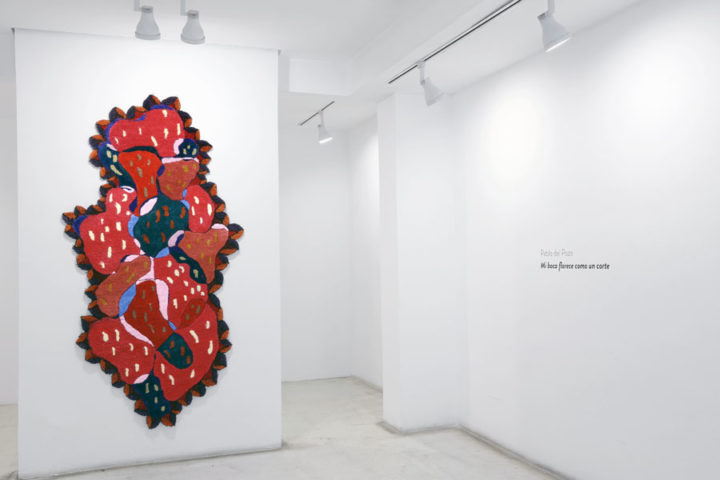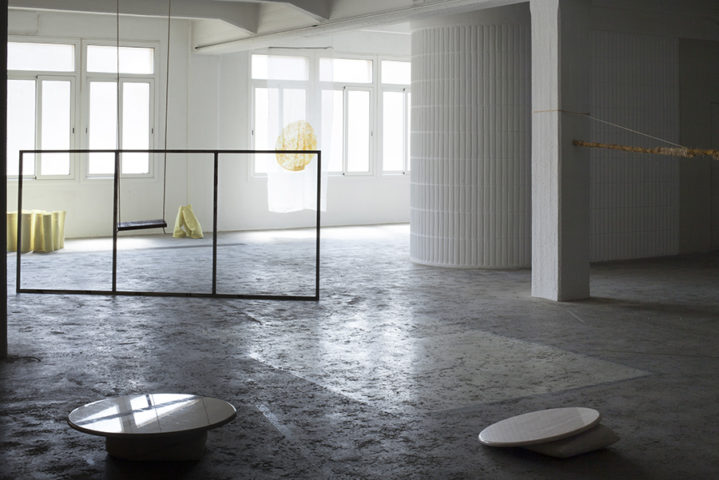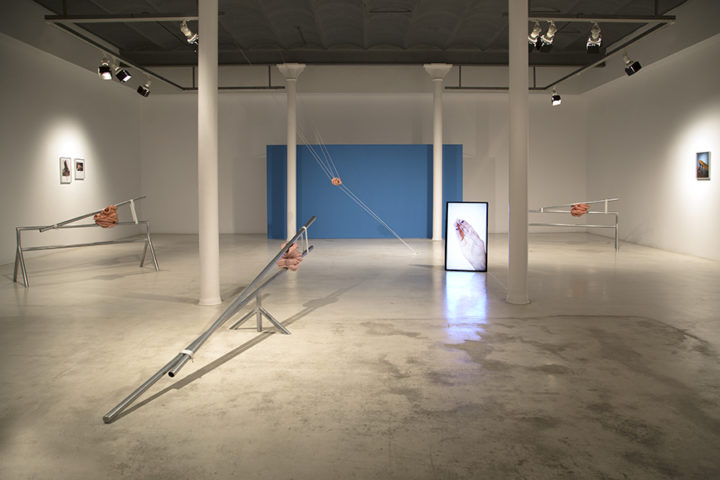June 15, 7pm : visit with the artist
July 20, 7pm : visit with the artist in conversation with Gisela Chillida
Before today my body was useless.
Now it’s tearing at its square corners.
Anne Sexton, “The Kiss“, Love Poems
We are pleased to present the first solo exhibition of Pablo del Pozo at Galeria Joan Prats, entitled Mi boca florece como un corte [My mouth blooms like a cut], which includes tapestries and recent sculptures in different fabrics and sizes.
After his exhibition Cuando iba, iba con ella, y cuando volvía, me encontré con ella (2018) at the gallery with Aïda Andrés Rodrigálvarez – in which Pablo del Pozo used materials such as clay, plaster, pigments and recovered objects, to talk about the scarcity of the life as an everyday reality-, now the artist opts for a new line of research in which he adopts unprecedented themes and materials in his work.
The title of the exhibition belongs to the first verse from the poem “The Kiss” by the American writer Anne Sexton (1928-1974). The fortuitous find of this example of poetry, whose core revolves around the idea that wounds can also cause beauty, has become a catalyst to take Poetry -in capital letters- as a form of understanding, passion and creation, especially poetry written by women authors, among which the poets Anne Sexton, Emily Dickinson or Anne Carson stand out.
Pablo del Pozo presents in this exhibition a multidisciplinary project focused on the germination of life and the celebration of desire in a new nature, in a new habitat. It is a formal investigation, mainly sculptural, for which he used textile materials, from twine and jute fabric to lycra and wool, made with some traditional techniques, mainly crochet, and also others more moderns like hand tufting. The artist has created the works by hand, in a laborious process that has required a long time to produce them and which, at the same time, has allowed him to revalue what are considered “feminine labors”.
The works of Mi boca florece como un corte are characterized by their organic forms, which refer to organisms such as flowers, hanging plants, but also to viscera or moist bodies, and whose conception has drawn on branches such as botany and zoology. For the wool, fabric and rope sculptures, together with the tapestries, Pablo del Pozo has based himself on the microscopic wefts of plant and human cells, which he has tried to replicate through sewing patterns. In the case of the lycra pieces, the petals are transfigured into a texture reminiscent of shiny skin in a state of perspiration, a sheen that refers to costume fabric and party clothes, to the enjoyment of life. The structure of the flowers – the reproductive organs of plants that attract fauna to expand and colonize the territory – leads us to the idea of desire as one of the central points of the exhibition.
Based on these images, Pablo del Pozo creates a natural environment where he can offer a haven that brings death and life closer. And it is that, as the writer and editor Patricia Castro affirms, about the display, “The multiplicity of the alive attacks the certainties of a world paved where the flowers have to grow in the hard shoulder. Are prevented from sprouting. Plant, animal, men or women now don’t mean the same. The end is near, do you feel it? Embrace it. And don’t be scared of the unknown. Welcome back to the life.”
Pablo del Pozo (Badajoz, 1994) lives and works in Barcelona. He graduated in Fine Arts from the University of Barcelona (2017). He has been selected at the Valls Biennial, Guasch-Coranty Award (2017), or which he has been part of the exhibition at the Centre Tecla Sala in l’Hospitalet de Llobregat (2018). He has been part of the circuit of the Jeune Création Européenne Biennial (2017-9) with exhibitions in museums in various European cities: Montrouge, France (2017); Hjorring, Denmark; Cēsis, Latvia; Cluj, Romania (2018); Como, Italy; Figueres, Spain, and Amarante, Portugal (2019). He has also received the creation award from the Sala d’art Jove de la Generalitat de Catalunya (2017), and he exhibited in the group show in this space in June 2018. He has recently been nominated for the Miquel Casablancas Award (2019), his work has been exhibited at Fabra i Coats, and, in the solo show Al muerto, tiempo encima, curated by Jordi Garrido, at the Fundació Arranz Bravo in l’Hospitalet de Llobregat.


